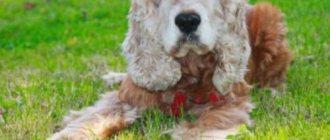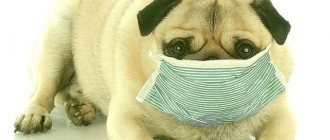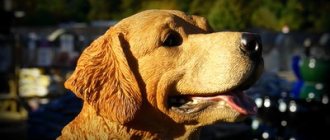Chihuahua is a breed of decorative dog, characterized by good health and longevity. Pet owners don’t often have to seek help from a veterinary clinic, but dogs have physiological characteristics that those who are just planning to get a puppy should know about.
It should come as no surprise to future owners that Chihuahuas often snore, snore, and cough. It is necessary to find out the nature and reasons for this peculiarity of animals, understand what the breeder needs to do and in what case it is necessary to immediately seek help from a veterinarian.
Why do Chihuahuas grunt, wheeze and cough?
Many dwarf breeds are characterized by periodic grunting, which is explained by the structural features of the muzzle. If it is short, a “reverse sneezing” effect occurs - due to irritation of the palate, a spasm of the pharynx occurs. The manifestation of the syndrome often frightens Chihuahua owners - the dog stretches its neck, arches its back, coughs as if it was choking, and the muscles of its chest tense. The dog may gasp for air, grunt loudly, or wheeze. It seems that he is suffocating and dying before our eyes. The owner of a Chihuahua should not worry; at this moment the pet is just trying to keep his cool. The attack lasts no more than 30 seconds - the dog lowers its head, coughs and soon stops grunting and begins to breathe normally.
There are several reasons why reverse sneezing occurs:
- the presence of a non-overgrowing fontanel;
- hypothermia;
- eating quickly;
- getting pollen or powder into the nose;
- strong odors;
- leash tension;
- a cleft in the palate or its sagging;
- polyps in the mouth;
- infections;
- obesity;
- emotional overexcitation;
- stress;
- heatwave.
At rest, the Chihuahua rarely sneezes and wheezes through its nose when breathing. The dog is not designed for active physical activity, so it is worth dosing it and avoiding stressful situations.
When does a Chihuahua have a coughing or wheezing attack?
This symptom almost never occurs when the dog is at rest. Spasmodic breathing occurs during:
- emotional overexcitation of the animal;
- walking on a leash if the dog breaks from it;
- in a state of high physical activity;
- extreme heat;
- stress;
- inhalation of strong odors.
Chihuahua owners should remember that the breed is not suitable for hunting or too active games. It is important to avoid situations that are stressful for the animal. When walking, it is better to wear a harness instead of a collar. In the hot season, walk for a short time, mostly in the shade.
Are these conditions dangerous for Chihuahuas?
A normal cough and sneeze ends quickly. It can be compared to the sounds a cat makes when coughing up fur. If the attack stops and the animal behaves as usual, there is no reason to worry.
It happens that a Chihuahua continues to make strange sounds for more than a minute and cannot calm down. In this case, help is needed.
It is worth taking your dog to the vet if the attacks have become not only prolonged, but also regular. One of the most serious causes of grunting is diseases of the cardiovascular system. You should pay attention to the color of the tongue. If he turns blue, you need to urgently seek help from a veterinarian.
Reverse sneezing
This condition causes exceptional anxiety for the dog owner, and sometimes even panic. “Reverse sneezing” is a rather unpleasant sight, when the attack is similar to a sharp breath, at the same time that the dog is not able to exhale on its own, a moment of lack of air occurs, the dog suffocates and coughs up.
Attacks of this kind cannot be called extremely frightening, however, there is no reason to panic. This process often appears suddenly, as suddenly as it goes away. In this regard, it is impossible to prepare for it and cannot come to terms with it. Experts have still not been able to identify the prerequisites for this phenomenon - “reverse sneezing”.
Reverse sneezing often appears suddenly, as suddenly as it goes away
Extremely similar to “reverse sneezing”, i.e. a situation when an animal has a foreign object in its nasopharynx. You will need to carefully monitor the dog and its movements so that it does not catch something unnecessary, and in the worst case, the owner manages to take it to the doctor.
Foreign object in the dog's throat. How to help your pet
Severe stress is quite similar to the reverse sneezing effect. In this regard, if the dog is extremely frightened, the owner should immediately begin examining his tongue. If he turns blue, there is a high probability of a heart attack - an urgent medical examination is required.
Why does a Chihuahua snore in its sleep?
In addition to the fact that sneezes grunt and cough, they can snore in their sleep. This touches some, makes others laugh, and still others does not let them sleep. Chihuahua snoring during sleep is most often associated with physiology (shortened muzzle) and does not in any way affect the quality of life. If your pet snores regularly, characteristic sounds appear suddenly during the day, this may be the first signal of the development of a serious pathology.
You should be wary if your Chihuahua constantly sniffles and sniffles, and grunts and makes gurgling sounds in its sleep. When symptoms are also accompanied by lethargy and refusal to eat, this is most likely an acute respiratory infection. The animal must be treated to prevent swelling of the nasopharynx, bronchitis and pneumonia.
The cause of snoring can be the Chihuahua's poor diet, in which case it is put on a special diet. Sometimes dogs snore due to dry mucous membranes when there is insufficient humidity in the apartment.
Symptoms of a cold
Viral and acute catarrhal rhinitis develops in three stages, with characteristic symptoms for each2:
1. Unpleasant tension and itching in the nose occur, which are accompanied by sneezing. Watery nasal discharge appears as a protective reaction of the mucous membrane to uncomfortable atmospheric conditions or the penetration of viruses. As well as fever, headache, general weakness.
2. Swelling of the mucous membrane occurs, making nasal breathing difficult and a nasal voice appearing. The perception of smells decreases, up to anosmia (loss of smell). Elevated temperature, lethargy, and drowsiness persist.
3. Nasal congestion persists, especially at night, which disturbs sleep. The color and consistency of nasal discharge changes (it becomes thick and acquires a yellow-greenish tint). Difficult-to-remove exudate causes congestion in the ears when blowing the nose, and a moderate headache.
With timely, competent treatment, a cold runny nose goes away in 7-10 days. Neglect of treatment leads to the spread of inflammation into the sinuses, auditory tube, and bronchi. Accordingly, complications such as rhinosinusitis, otitis media, and bronchitis develop.
Chihuahua is choking and grunting: what to do
If the Chihuahua's grunting is not due to a disease, but to a breathing pattern, neither medication nor special treatment is needed. During an attack of “reverse sneezing,” the owner should not panic or irritate the pet.
In order for the dog to stop grunting, they act according to the following scheme:
- They take the sneeze in their arms and try to calm it down - they stroke it and call it affectionately.
- Lightly press on the nostrils so that the dog breathes through the mouth, and then relieve the spasm by stroking the neck with the palm of your hand.
- Rub the bridge of the nose and allow air to enter the nasal passages.
- Open the chihuahua's mouth and press on the root of the tongue.
If all manipulations do not help, the dog’s jaws are spread wide. She begins to squeak and struggle, and at this moment the airways open and the grunting stops.
Prevention measures
If, for example, a Spitz grunts and wheezes, as if it is suffocating, in order to avoid unpleasant symptoms you should:
- provide your pet with a balanced and varied diet;
- organize a room for keeping the dog so that it is warm, protected from winds and cold;
- do annual preventive deworming;
- double-check the sanitary and hygienic standards for keeping the animal.
A balanced diet is essential to maintaining your pet's health.
When should you contact a veterinarian?
The cause of wheezing may lie not only in the structural features of the respiratory system. You should seek help from a veterinarian if alarming symptoms appear:
- Attacks are occurring more frequently and lasting more than two minutes – heart disease is possible.
- Shortness of breath due to excess weight.
- Copious nasal discharge – acute, infectious or allergic rhinitis.
- Loss of consciousness - suffocation due to poisoning, asthma, heat stroke, vasospasm, injury.
According to veterinarians, the reason why a Chihuahua constantly sneezes, grunts, groans and breathes heavily may be an inflammatory process or an allergy. To make a diagnosis, the dog is taken to the clinic and undergoes a full examination.
How to treat
If you notice that your pet has begun to breathe heavily, sneeze and cough, do not leave things to chance, take action and contact a veterinarian.
A cold cough lasts only 2-3 days and goes away on its own. There is no need to treat it; it can harm the health of the animal.
Important ! Do not mindlessly give “human” coughing and expectorant medications to a sick animal. Without knowing the dosage, you can cause an allergic reaction and other side effects.
It should be understood that coughing is only a symptom that can only be correctly interpreted after a complete examination of the dog.
Have your dog checked regularly by a veterinarian
If the animal coughs for 2-3 days, wait; if the condition worsens, go to the veterinary clinic immediately.
Diagnosis of respiratory organs
As a rule, diagnostics of the respiratory system is carried out according to the following scenario:
- Detailed external examination of the pet , paying attention, first of all, to the condition of all its visible mucous membranes and fur, as well as to the characteristics of breathing (even, intermittent, deep or superficial, etc.).
- Auscultation (listening) of the chest . It is so easy to identify moist rales, “seething” and gurgling in the lungs, and other important symptoms.
- Percussion of the chest (tapping). An experienced specialist can identify changes and shifts in the boundaries of internal organs (lungs and heart), and suggest the presence of fluid or air in the cavity.
Neoplasms
Cancerous tumors also fall into the category of foreign bodies in the respiratory tract. In what cases should a dog be taken to the veterinarian as soon as possible for a comprehensive examination? This is recommended when sniffing and grunting develop gradually, over several months or even years. In addition, during the stages when clearly visible breathing problems and coughing develop, the dog usually begins to feel unwell. He quickly gets tired, becomes apathetic, may refuse his favorite food, and may experience a “bad” runny nose, in which, in addition to the “standard” exudate, blood clots and pieces of destroyed tissue may be released from the pet’s respiratory tract. All these symptoms usually force even the most inattentive owners to urgently take their pet to the clinic.
Nasal congestion during pregnancy
This is a very common problem associated with hormonal changes in women during this period.
Typically, rhinitis in women during pregnancy belongs to the group of non-infectious runny noses - vasomotor rhinitis (unless, of course, the woman has a cold or an infectious disease).
The main symptom is that the nose alternates between one and the other nostril. Unpleasant symptoms cause a lot of inconvenience, often intensifying towards the end of the gestation period. To prevent overwork, chronic fatigue and other negative factors, you should use nasal decongestants without runny nose, approved for pregnant women.
Treatment
At home
It is not recommended to treat your dog yourself. It is better to monitor his diet, give him healthy vitamins, love and care.
At the veterinary clinic
Specialists are able to conduct a full examination of the Chihuahua, identify possible causes of illness, voice the correct diagnosis, and prescribe treatment.
If your pet is weak and apathetic towards the world around you, you should call a doctor at home. After the examination, he will decide whether to take the pet to the clinic for a thorough examination, and what treatment to prescribe.
Sedative
- Benzodiazepines . These are short-term, fast-acting drugs. They help relieve symptoms of phobia and severe anxiety.
- Nonbenzodiazepine tranquilizers (Azapirones) are antiphobic drugs.
- Tricyclic antidepressants (TCAs). Used for fear, phobias, neuroses.
- Serotonin reuptake inhibitors. They treat aggression, anxiety, fear of loneliness, and panic disorders.
- Muscle relaxants and general narcotic substances . Necessary for anesthesia and short-term manipulations.
How to remove fleas?
Use:
- collars – Bolfo, Kiltix, Coastal;
- drops – Hartz, Bars.
It is better not to use shampoos. Chihuahuas have a weak body. If the shampoo is not thoroughly washed off, the dog will instantly become poisoned.
Chihuahua illnesses are not the most pleasant phenomena. Some illnesses are curable, and some are not. It is important to monitor the general condition of the pet, administer vaccinations in a timely manner, and try in every possible way to protect it from various adverse effects. If you follow the tips and recommendations, your pet will be able to live a long and happy life.
Tracheal collapse
A very unpleasant pathology, dangerous in its suddenness and complete unpredictability. As can be understood from the name, the trachea “shrinks”, its lumen sharply decreases (sometimes to the point of complete obstruction), as a result of which the animal can not only grunt, but even “quack” and wheeze, like an inveterate drunkard. This whole “zoo” actually doesn’t look so funny: the dog suddenly becomes ill, he can’t breathe in the air normally, he’s suffocating, he sits with his mouth wide open. If you look closely, all the mucous membranes in it turn out to be colored bluish or even purple, which indicates an extremely serious degree of hypoxia. When such a low level of hypoxia persists for several hours (or even minutes, depending on your luck), the animal may fall into a coma, or subsequently begin to have seizures.
hesitate - immediately take your pet to the clinic . In severe and even relatively severe cases, a tracheotomy has to be performed. That is, the surgeon will carefully cut the tissue of the trachea in the space between its rings, after which he will perform intubation (insert a special plastic tube into the lumen of the organ). Only after this the dog will be able to breathe normally and there will be no danger of suffocation. Again, if tracheal collapse has developed as a result of some dangerous pathologies and its rings are damaged, they resort to a much more complex operation.
What symptoms should you be wary of?
If a Spitz is choking and grunting, the owner should be alerted to symptoms such as:
- cough;
- weight loss;
- dyspnea;
- vomit.
In this case, the breed of the dog that grunts does not matter. For any representative of four-legged animals, such symptoms will not be a joy.
A dog's cough is a good reason to visit a veterinary clinic.











